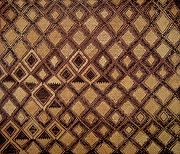
Velours du Kasaï
Encyclopedia

Kasai Province
Kasai is one of 25 new provinces of the Democratic Republic of the Congo specified in the country's 2005 Constitution , under Article 2. It was to be created from country's the existing 10 provinces within 36 months , according to Article 226...
, a province in the Democratic Republic of the Congo
Democratic Republic of the Congo
The Democratic Republic of the Congo is a state located in Central Africa. It is the second largest country in Africa by area and the eleventh largest in the world...
(Zaïre). Traditionally, the weaving is done by men of the Shoowa from the Kuba
Kuba
Kuba may refer to:In places*Kuba, Tibet*Quba , capital of Quba Rayon, Azerbaijan*Quba Rayon, a district of Azerbaijan*Quba Khanate, an independent principality from 1747-1806, part of modern-day Azerbaijan...
ethnic group, while the embroidery is reserved to women. Ideally, the embroiderers should be pregnant. The technique is still practised.
Originally the cloth was made using beaten wood bark but, since the introduction of raffia, only vestiges of this remain. Some belts (duun) are still made in bark; they symbolize power and may be worn only by certain nobles. Bark is still used for certain loincloths for women (Ishyeen). The center of these loincloths is formed of many triangles of bark, alternately black and white. These are cut out of the raw bark either natural, or dyed black and sewn together. The choice of this method rather than that of drawing is significant - for the Kuba, value is measured by a work's difficulty.
The fabric is made of very fine fibre from the inside of the leaves of young palm trees. The leaves are dried in the sun, then split along their length and connected to form a basic warp of raffia, from 2m to 4m in length. Fine leaf fibres are then interweaved in a woof to create the velvet effect. This is then wrapped around the waist to create a loincloth known as Mapel (for men) or Ntshak (for women).
The designs are very varied and are created spontaneously but normally follow the body scarification patterns of the Kuba.
The cloth is heavy and expensive and is not normally intended to be worn, but is used as a bed covering or on the royal throne. Individual items take from several months to a year to produce. Cloths were used as currency or given as gifts.

